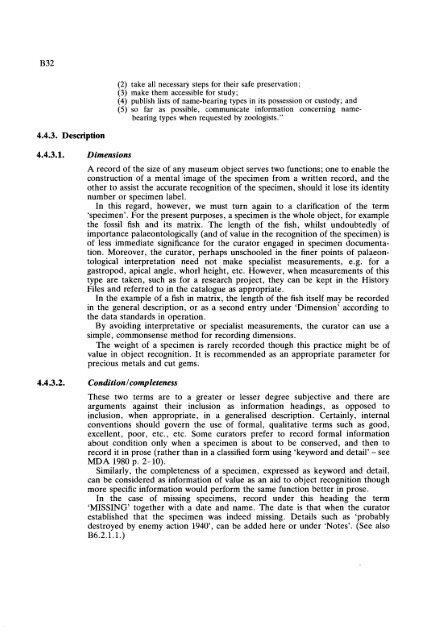GUIDELINES FOR THE CURATION OF GEOLOGICAL MATERIALS
GUIDELINES FOR THE CURATION OF GEOLOGICAL MATERIALS
GUIDELINES FOR THE CURATION OF GEOLOGICAL MATERIALS
Create successful ePaper yourself
Turn your PDF publications into a flip-book with our unique Google optimized e-Paper software.
(2) take all necessary steps for their safe preservation;<br />
(3) make them accessible for study;<br />
(4) publish lists of name-bearing types in its possession or custody; and<br />
(5)'so far as possible, communicate information concerning namebearing<br />
types when requested by zoologists."<br />
4.4.3. Description<br />
4.4.3.1. Dimensions<br />
A record of the size of any museum object serves two functions; one to enable the<br />
construction of a mental image of the specimen from a written record, and the<br />
other to assist the accurate recognition of the specimen, should it lose its identity<br />
number or specimen label.<br />
In this regard, however, we must turn again to a clarification of the term<br />
'specimen'. For the present purposes, a specimen is the whole object, for example<br />
the fossil fish and its matrix. The length of the fish, whilst undoubtedly of<br />
importance palaeontologically (and of value in the recognition of the specimen) is<br />
of less immediate significance for the curator engaged in specimen documentation.<br />
Moreover, the curator, perhaps unschooled in the finer points of palaeontological<br />
interpretation need not make specialist measurements, e.g. for a<br />
gastropod, apical angle, whorl height, etc. However, when measurements of this<br />
type are taken, such as for a research project, they can be kept in the History<br />
Files and referred to in the catalogue as appropriate.<br />
In the example of a fish in matrix, the length of the fish itself may be recorded<br />
in the general description, or as a second entry under 'Dimension7 according to<br />
the data standards in operation.<br />
By avoiding interpretative or specialist measurements, the curator can use a<br />
simple, commonsense method for recording dimensions.<br />
The weight of a specimen is rarely recorded though this practice might be of<br />
value in object recognition. It is recommended as an appropriate parameter for<br />
precious metals and cut gems.<br />
4.4.3.2. Conditionl completeness<br />
These two terms are to a greater or lesser degree subjective and there are<br />
arguments against their inclusion as information headings, as opposed to<br />
inclusion, when appropriate, in a generalised description. Certainly, internal<br />
conventions should govern the use of formal, qualitative terms such as good,<br />
excellent, poor, etc., etc. Some curators prefer to record formal information<br />
about condition only when a specimen is about to be conserved, and then to<br />
record it in prose (rather than in a classified form using 'keyword and detail' - see<br />
MDA 1980 p. 2-10).<br />
Similarly, the completeness of a specimen, expressed as keyword and detail,<br />
can be considered as information of value as an aid to object recognition though<br />
more specific information would perform the same function better in prose.<br />
In the case of missing specimens, record under this heading the term<br />
'MISSING' together with a date and name. The date is that when the curator<br />
established that the specimen was indeed missing. Details such as 'probably<br />
destroyed by enemy action 1940', can be added here or under 'Notes'. (See also<br />
B6.2.1.1.)

















